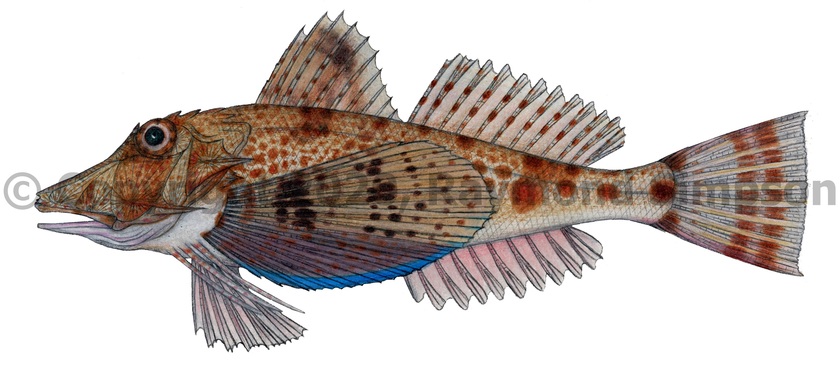
Common Name
Bluewing Searobin
Year Described
Bloch, 1793
Identification
Dorsal Fin: X, 12
Anal Fin: 10
Pectoral Fin: 13-14
Body relatively stout but elongate and slightly compressed . Head is large, bony, and heavily sculptured with pronounced ridges and spines. Head relatively deep. Duck-billed snout is relatively short. Mouth is subterminal and large in size, containing bands of villiform teeth on the jaws, vomer, and palatines. Jaw reaches front edge of orbit. No spines at nostrils. Preopercle and opercle usually bear strong spines. Preopercular spine reaches edge of opercle. Large, fan-like pectoral fins with strongly branched rays, with the lower three rays free, thickened, and separate from the fin membrane. Pectoral fin viewed from above squared off anteriorly and broadly rounded posteriorly. Pectorals when folded reach middle of anal fin base. Two dorsal fins: one spiny and one soft rays. Anal fin opposite soft dorsal fin. Caudal fin is truncate. Pelvic fin underneath pectoral fin on belly. Body covered in small ctenoid scales with the exception of the naked ventral surface. Nape scaled. Opercular membrane above spine partially scaled. Lateral line is continuous.
Color
Body whitish to gray or brown. Numerous small brown to reddish spots on head and dorsum. Flanks with much larger blotches in a linear series. Often displays oblique body bands and a band between and under the eyes. Belly pale. Dorsal fins variably dark or pale with reddish spots along spines/rays. Spiny dorsal with a dark area between spines 3-5 but no ocellus or distinct spot. Pectoral fin golden to reddish brown with three thick and one thin darker brown crossband (either solid or made up of blotches) on the posterior 2/3 of fin. Anterior third plain brown with paler rays and a striking blue margin. Pectoral fin free rays red banded. Anal and pelvic fins pale or reddish with reddish rays. Caudal fin with two close set post-median bands and one basal band.
Size
Maximum size to 20cm SL.
Habitat
Soft bottoms from 7-190m (usually <30m).
Range
Mexico (SW GOM) to northern Argentina, including the Caribbean Sea. Occurs on both continental and insular coasts.
References
McEachran, J. D. & J. D. Fechhelm. 2005. Fishes of the Gulf of Mexico. Volume 2: Scorpaeniformes to Tetraodontiformes. University of Texas Press, Austin. i-viii +1-1004.
Richards, W. J. & G. C. Miller. 2003. Triglidae (pp. 1266-1277). In: Carpenter, K. E. (ed.) 2003. The living marine resources of the Western Central Atlantic. Volume 2: Bony fishes part 1 (Acipenseridae to Grammatidae). FAO species identification guide for fishery purposes and American Society of Ichthyologist and Herpetologists Special Publication No. 5. FAO, Rome. v. 2: i-vii + 602-1373.